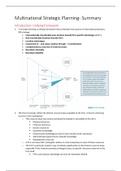Multinational Strategic Planning- Summary
Introduction- Unifying framework
1. 7 concepts forming a unifying framework that constitutes the essence of international business
(IB) strategy
1. Internationally transferable (non-location-bound) firm-specific advantages (FSA’s)
2. Non-transferable (location-bound) FSA’s
3. Location advantages
4. Investment in – and value creation through – recombination
5. Complementary resources of external actors
6. Bounded rationality
7. Bounded reliability
2. The first 3 concepts reflect the distinct resource base available to the firm, critical to achieving
success in the marketplace
o This resource base has various components (owned or accessible to the firm)
▪ Physical resources
▪ Financial resources
▪ Human resources
▪ Upstream knowledge
▪ Downstream knowledge (critical to the interface with customers)
▪ Administrative (governance-related) knowledge
▪ Reputational resources
o A firm can have FSA’s (strengths relative to rival companies) in each of these resources
o The firm’s particular location may contribute significantly to this distinct resource base,
especially if this location provides privileged access to specific resources external to the
firm itself
▪ FSA’s and location advantage can thus be intimately related
, o Routines reflect the distinct ability to combine further the above resources, in unique
ways valued by the firm’s SH
▪ They’re stable patterns if decisions and actions that coordinate the productive
use of resources, and thereby generate value
▪ The combination ability expressed in routines is a higher-order FSA
o Knowledge management systems themselves, though at the heart of knowledge transfer
within MNE’s, may face a variety of problems when diffused throughout the MNE
network
▪ The failure to transfer routines effectively may have broader spillover effects to
the MNE as a whole
▪ International transfer difficulties in part reflect the presence of generic
differences between home and host countries (these differences require
adaptation and a recombination capacity)
➢ The 4th concept is the heart of IB strategy: international corporate success requires more than
just routines, whether internationally transferable or location-bound ones
o The highest-order FSA is the ability not just to combine reliably the MNE’s existing
resources, but to recombine its resources in novel ways, usually including newly
accessed resources
o In the international context, MNE’s must engage in the artful orchestration of resources
as a response to differences between national and foreign environments
o Recombination doesn’t just mean adding new resources and managerial practices to
existing ones
▪ It by definition means foregoing at least some standard resources and standard
practices before a new business opportunity can successfully be acted upon
➢ The 5 concept represents additional resources, provided by external actors but accessible to
th
the MNE, which may be necessary to fill resource gaps and achieve success in the marketplace
➢ The 6th and 7th concept reflect behavioral characteristics that may impede international success
o Bounded rationality: limits to the capacity of individuals to absorb, process and act upon
complex and often incomplete information
o Bounded reliability: insufficient effort to deliver on promised behavior or performance
Part I- Core concepts
1. Conceptual foundations of international business strategy
1.1 Internationally transferable FSA’s and the four MNE archetypes
➢ When crossing its home country border to create value in a host country, the MNS is at a
disadvantage as compared to firms from the host country
o Because the firms possess a knowledge base that is more appropriately matched to local
SH requirements
The MNE incurs additional costs of doing business abroad
➢ In order to overcome the additional costs, the MNE must have proprietary internal strengths,
such as technological, marketing or administrative knowledge
o = non-location-bound FSA’s
▪ These don’t stop creating value when the border is crossed, though their precise
value may be somewhat different in the 2 countries
➢ In principle, the MNE can transfer, deploy and exploit these FSA’s successfully across borders
o They can be embodied in final products; like when the MNE exports goods and services
that are valued highly by host country customers
, o When faced with natural or government-imposed trade barriers, the MNE may transfer
some FSA’s abroad directly, as ‘intermediate’ products
➢ The exploitation of FSA’s transferred abroad can also be done by external actors (licensees) or by
network partners (joint ventures or distributors), who may add their own complementary
resources to the foreign operation and thereby strengthen the MNE’s position
➢ Paradox of internationally transferable FSA:
o If the FSA consists of easily codifiable knowledge, it can be cheaply transferred and
effectively deployed and exploited, but it can also be easily imitated by other firms
▪ The cost of transfer, deployment and exploitation is relatively low, but the value
derived from it may also be relatively low
➢ MNE’s face great difficulty transferring, deploying and exploiting FSA’s that consist of tacit
knowledge
o It cannot be fully replicated through simple communication channels; it requires person-
to-person communication,
o Though it is expensive and time-consuming to transfer, the benefit to the MNE is that
this knowledge is also difficult to imitate
▪ It is therefore a key source of competitive advantage
➢ Perhaps the most important bundle of tacit knowledge is contained in the MNE’s administrative
heritage: the key routines developed by the firm since its inception
o 4 different archetypes:
▪ Centralized exported: home-country managed firm builds upon a tradition of
selling products internationally, out of a number of facilities in the home
country, and with only minor (customer-oriented) value-creating activities
abroad
• Standardized products manufactured at home embody the firm’s FSA’s
• The foreign subsidiaries act largely as facilitators of efficient home
country production
• Multinational activities occur primarily in the downstream end of the
value chain (related to marketing, distribution and related logistics)
• Eg.: Japanese MNE’s
▪ International projector: builds upon a tradition of transferring its proprietary
knowledge developed in the home country to foreign subsidiaries, which are
essentially clones of the home operations
• Knowledge-based FSA’s developed in the home country are transferred
to subsidiaries in host countries
• International projection requires the systematic and continuous transfer
of tacit knowledge to multiple locations, so this firm relies on an
extensive cadre of professional managers who can act as expatriates
• Eg.: American MNE’s
▪ International coordinator: builds upon a tradition of managing international
operations, both up- and downstream, through a tightly controlled but still
flexible logistics function
• International operations are specialized in specific value-added activities
and form vertical value chains across borders
• The key FSA’s are in efficiently linking these geographically dispersed
operations through seamless logistics
• Eg.: large MNE’s in natural resources industries
, o They search for relevant resources internationally, manufacture
them in the most cost-efficient locations and sell the product
wherever there is demand
▪ Multi-centered MNE: consists of a set of entrepreneurial subsidies abroad,
which are key to knowledge-based FSA development
• National responsiveness is the foundation of the international strategy
• Non-location-bound FSA’s that hold these firms together are minimal:
common financial governance and the identity and specific business
interests of the founders or main owners
• It should be viewed as a portfolio of large, independent businesses
• Eg.: older European MNE’s
➢ Commonality among all 4 archetypes: the transfer of at least some FSA’s across borders
➢ Some firms don’t fit within the archetypes
o Emerging economy MNEs typically don’t derive their strengths primarily from advanced
technology, brand names of a sophisticated logistics apparatus
▪ Building upon generally available resources in their home country, these firms
thrive on recombining whatever FSA’s they may possess with resources accessed
abroad
o Even when supported by cheap home country resources and ac activist home nation
government with deep pockets, international success will only materialize if the EMNE
can effectively link new knowledge and other assets sourced abroad, with a set of
internal strengths
➢ Whatever archetype an MNE falls under, history suggests that it will usually overestimate the
international transferability from a mere technical standpoint, the potential for foreign
deployment and the potential exploitation of its FSA’s
o Even when knowledge transfer across borders is achieved rather easily, contextual
variables change
➢ What may constitute and FSA in the home country doesn’t necessarily confer the same value in
a foreign context
o Upstream resource bundles may have universal, transferable appeal, but this doesn’t
usually hold for downstream strengths, where the interface with the customer is key
1.2 Non-transferable (or location-bound) firm-specific advantage
➢ 4 main types of location-bound FSA’s:
1. Stand-alone resources linked to location advantages
▪ Like a network of privileged retail locations, which are immobile
2. Other resources such as local market knowledge and reputational resources
▪ May not have the same value across borders, either because they are not
applicable to a host country context or because they are simply not valued to
the same extent
3. Local best practices
▪ May not be considered as such abroad by a variety of SH, and may even be
deemed illegal
4. The firm’s domestic recombination capability
▪ May have led to a dominant market share and superior expansion rate at home,
but may not be adept enough to confront the additional complexity of foreign
markets





